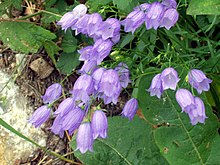
Back جريسية Arabic جريسيه ARZ Campanulaceae AST Zəngçiçəyikimilər Azerbaijani Званочкавыя Byelorussian Званочкавыя BE-X-OLD Камбанкови Bulgarian Campanulaceae BS Campanulàcies Catalan Campanulaceae CEB
| Campanulaceae | |
|---|---|

| |
| Campanula cespitosa | |
| Scientific classification | |
| Kingdom: | Plantae |
| Clade: | Tracheophytes |
| Clade: | Angiosperms |
| Clade: | Eudicots |
| Clade: | Asterids |
| Order: | Asterales |
| Family: | Campanulaceae Juss.[1] |
| Genera | |
|
See text | |
The family Campanulaceae (also bellflower family), of the order Asterales, contains nearly 2400 species in 84 genera of herbaceous plants, shrubs, and rarely small trees, often with milky sap.[2] Among them are several familiar garden plants belonging to the genera Campanula (bellflower), Lobelia, and Platycodon (balloonflower). Campanula rapunculus (rampion or r. bellflower) and Codonopsis lanceolata are eaten as vegetables. Lobelia inflata (indian tobacco), L. siphilitica and L. tupa (devil's tobacco) and others have been used as medicinal plants. Campanula rapunculoides (creeping bellflower) may be a troublesome weed, particularly in gardens, while Legousia spp. may occur in arable fields.
Most current classifications include the segregate family Lobeliaceae in Campanulaceae as subfamily Lobelioideae. A third subfamily, Cyphioideae, includes the genus Cyphia, and sometimes also the genera Cyphocarpus, Nemacladus, Parishella and Pseudonemacladus. Alternatively, the last three genera are placed in Nemacladoideae, while Cyphocarpus is placed in its own subfamily, Cyphocarpoideae.
This family is almost cosmopolitan, occurring on all continents except Antarctica. In addition, species of the family are native to many remote oceanic islands and archipelagos. Hawaii is particularly rich, with well over 100 endemic species of Hawaiian lobelioids. Continental areas with high diversity are South Africa, California and the northern Andes.
Habitats range from extreme deserts to rainforests and lakes, from the tropics to the high Arctic (Campanula uniflora), and from sea cliffs to high alpine habitats.
- ^ Angiosperm Phylogeny Group (2009), "An update of the Angiosperm Phylogeny Group classification for the orders and families of flowering plants: APG III", Botanical Journal of the Linnean Society, 161 (2): 105–121, doi:10.1111/j.1095-8339.2009.00996.x, hdl:10654/18083
- ^ Lammers, Thomas (2011). "Revision of the Infrageneric Classification of Lobelia L. (Campanulaceae: Lobelioideae)". Annals of the Missouri Botanical Garden. 98: 37–62. doi:10.3417/2007150. S2CID 84676862.